2. 中国科学院大学,北京 100049;
3. 陕西延长石油(集团) 有限责任公司,西安 710075
2. University of Chinese Academy of Sciences, Beijing 100049, China;
3. Shaanxi Yanchang Petroleum (Group) CO. LTD, Xi'an 710075, China
在层状的坚硬沉积岩层中,节理的发育一般会终止于岩层面,这一界面被定义为力学层边界(Narr and Suppe, 1991;Gross et al., 1995)。两个力学层边界面限定的节理高度即是力学层厚度(MLT,mechanical layer thickness),它可能是单个岩层的厚度,也可能是几个岩层的厚度。对节理间距的大量实测表明,发育于层状沉积岩层中的节理经常会表现出规则性的节理间距(Hobbs,1967;Huang and Angelier, 1989;Narr and Suppe, 1991;Gross,1993;Engelder et al., 1997;Ji and Saruwatari, 1998)。垂直于节理面的局部张应力在邻近节理处会逐渐降低,阻止在已有节理附近进一步形成新的节理,从而影响节理间距;应力扰动在节理面侧向上影响范围宽度与节理高度成一定的比例关系,这里的节理高度等同于力学层厚度。尽管应力在侧向上扰动对节理的发育起到一个基本的控制作用,但是大量的研究实例表明层厚与节理间距之间的线性关系不是一定的,因为节理的形成同时还受到岩性、构造应变的大小等因素的影响(Hobbs,1967;Narr and Suppe, 1991;Gross,1993;Ji and Saruwatari, 1998;Bai and Pollard, 2000)。
根据对节理间距与岩层厚度比例关系的普遍观察,一些学者提出在具有“饱和”节理的岩层,任何垂直于节理方向的应变都将被其他类型的变形吸收(例如:层间滑动、已存在节理的开启度增大),而不是形成新的节理(Narr and Suppe, 1991;Wu and Pollard, 1995;Renshaw,1997)。在节理饱和度理论中,密集的节理会使其间的张应力急剧降低(Hobbs,1967) 和节理邻近区压应力的出现(Bai and Pollard, 2000),从而阻止了节理的进一步发育。然而野外观察却发现局部应变可能导致节理的密集产生,并且往往超出了节理饱和度的限定,这使得节理饱和度理论受到一些学者的质疑(Becker and Gross, 1996;Gross et al., 1997)。如果将这些观察用于对节理发育程度的评估,会发现节理的发育是一逐步充填(infilling) 的过程(Gross,1993),一般层厚与间距比值关系可以简单地反映出在多数地质背景下垂直于节理的有效张应力占主导地位。
1.2 节理与应力方向前人的研究表明(Zoback and Zoback, 1980;Zoback,1992;Hancock,1985;Eyal et al., 2001;Darby and Ritts, 2002;Zhang et al., 2011):(1) 板块尺度的区域内易受到统一的远程应力场影响,比如来自于板块边缘活动带的远程应力;(2) 可以通过区域上构造现象的识别来界定相关区域构造活动影响的范围和期次。张节理是最常见的脆性变形构造,它属于开启模式的破裂(图 1a,Scholz,1990),几乎见于各种构造环境下。张节理沿着最大压应力(σ1) 和中间压应力(σ2) 组成的面上传播,同时垂直于最小压应力(σ3,即最大张应力),所以张节理可以作为局部应力场方向的指示标志(Hancock et al., 1984, 1985;Dyer,1988;Pollard and Aydin, 1988;Hancock and Engelder, 1989;Hancock et al., 1991;Caputo,1995;Eyal,2001;Bai et al., 2002)。垂直节理、岩脉(Muller and Pollard, 1977) 和系统节理(Hodgson,1961a;Engelder and Geiser, 1980) 都定向排列平行于最大的水平压应力方向,都可以用于重新构建古应力方向。此外,正交节理系统的形成机理也可以用于判断区域应力的旋转与否以及局部应力的扰动情况(Gross,1993;Engelder and Gross, 1993;Rives et al., 1994;Caputo,1995;Bai, 1999, 2002)。许多学者对不同区域发育的正交节理系统进行过野外研究和实验室模拟研究(Hancock et al., 1987;Rives et al., 1994;Caputo,1995;Bai et al., 2002;Mandl,2005)。此外,新构造期形成的节理一般都平行于现今区域应力场的方向,所以也可以用于绘制新构造应力场的方向(Engelder,1982;Hancock,1988;Hancock and Engelder, 1989;Gross and Engelder, 1991;Hancock,1991;Khadkikar,2002)。

|
图 1 破裂基本模式 (a) mode Ⅰ,开启模式;(b) mode Ⅱ,沿破裂面剪切或滑动;(c) mode Ⅲ,反平面剪切或撕裂模式 Fig. 1 The fundamental fracture modes (a) mode Ⅰ, opening mode; (b) mode Ⅱ, in-plane shear or sliding mode; (c) mode Ⅲ, anti-plane shear or tearing mode |
本文将通过对鄂尔多斯盆地东南部中生界地层节理发育特征的初步研究成果,重建研究区中生代以来构造及应力场演化史,揭示裂缝形成的机理与主控因素。通过这一研究,为认识该盆地东南部页岩气成藏机理,探讨泥质岩裂隙系统发育规律。建立裂隙发育特征与泥岩裂隙系统分布预测之间的关系,这对页岩气勘探开发具有十分重要的意义。从柏林教授生前曾在张文佑院士领导下对华北断块区中生代火山岩及其与地质构造的关系进行研究(从柏林和张雯华,1984)。在从柏林教授逝世十周年之际,谨以此文献上,以志纪念。
2 鄂尔多斯盆地的区域构造背景鄂尔多斯盆地位于华北板块西部,是在古生代稳定的浅海沉积基础上发育起来的大型陆内复合型盆地(图 2)。它东起吕梁山脉,西至桌子山-贺兰山-六盘山一线;北抵阴山山脉,南达到秦岭,面积约250000km2(图 2)。从地层记录和岩相古地理变迁历史分析,鄂尔多斯盆地经历了稳定的早古生代浅海浅海陆棚、晚古生代滨浅海、中生代内陆湖盆、新生代周缘断陷等多期演化阶段(罗建强和何忠明2008;赵振宇等,2012)。

|
图 2 鄂尔多斯盆地构造简图(据Darby and Ritts, 2002修改) 淡灰色区域为华北板块; 灰色区域为晚侏罗至早白垩陆内的挤压变形; 深灰色区域为秦岭造山带(二叠纪-三叠纪); 斑点区域为鄂尔多斯盆地内未变形的中生代地层; 方格区域为蒙古弧地体 Fig. 2 Simplified structural map of Ordos Basin (after Darby and Ritts, 2002) Light gray shading represents the North China Block; Medium gray represents the areas of Late Jurassic-Early Cretaceous contractional intraplate deformation; Dark gray indicates the Qinling Orogen (Permian-Triassic); Stippled pattern shows the undeformed Mesozoic strata of the Ordos Basin, grid areas represents the Mongolian Arcs Terrane |
鄂尔多斯盆地是从中生代开始与华北板块东部发生了构造分异(陈晋镳和武铁山,1997;Meng et al., 1997)。伴随着南部晚三叠世时秦岭洋的闭合和华南-华北板块的陆-陆碰撞作用,鄂尔多斯盆地演化为大型陆内湖盆(Enkin et al.1992;Meng and Zhang, 2000)。中-晚侏罗世时期,湖盆发生了东西向重大构造分异,现今鄂尔多斯盆地的构造-地貌格局正是在中晚侏罗世以来至新生代时期逐渐形成的(程守田等,1997;高山林等,2000;赵振宇等,2012)。虽然鄂尔多斯盆地到三叠纪末整体演化成陆内盆地,但此后仍然持续受到周缘造山事件远程效应的影响,如藏南地块向北的拼贴、蒙古-鄂霍次克海的闭合,以及古太平洋向欧亚板块的俯冲等远程应力场的影响(Enkin et al., 1992;Zorin et al.1999;Darby and Ritts, 2002;董树文等,2007)。中生代早期,鄂尔多斯盆地周缘造山带主要表现为近东西向,北边的是阴山-燕山陆内造山带,南边的是秦岭-大别超高压碰撞造山带(Meng and Zhang, 2000;Ritts et al., 2001;Davis and Darby, 2010)。中生代盆地周缘持续有变形作用,但此时以近南北走向的构造带表现尤为突出,盆地西缘的贺兰山和六盘山褶皱冲断带和东缘的山西断皱带(廖昌珍等,2007;Liu,1998;Darby and Ritts, 2002)。自侏罗纪以来鄂尔多斯盆地周缘发生了多期构造变形事件,而盆内的构造响应并不明显;我们野外调查过程中并没有见到有区域代表性的褶皱和冲断作用及其相关的变形方式;只是以区域上大量发育节理,其可能代表了板块边缘构造活动的远程影响。
鄂尔多斯盆地出露的地层从盆地东部边缘向盆地内部逐渐变新,依次出露太古界、元古界、下古生界、石炭系、二叠系、三叠系、侏罗系和白垩系,地层产状向西缓倾,是东部逐渐抬升的结果。鄂尔多斯盆地中生界保存较完整,主要为内陆湖泊、河流、沼泽相沉积,沉积地层厚度约500~3000m,岩性主要以砂泥岩为主,局部有砾岩。晚白垩世至古新世,鄂尔多斯盆地受挤压而抬升,这段时期的沉积地层普遍缺失,新生代沉积地层厚度不足300m。
三叠纪末,鄂尔多斯盆地南缘秦岭洋闭合,华北板块处南北汇聚的挤压构造格局之中(张泓,1996;万天丰和朱鸿,2002;徐黎明等,2006;王鸿祯等,2006;董树文等,2007;Ritts,et al., 2009;Hou,2010)。与此同时,盆地西南缘晚三叠世-早侏罗世沉积地层的缺失,被认为是由盆地西南缘受到来自羌塘地块向北与柴达木地块拼贴和松潘-甘孜褶皱带形成的向NE方向的远程挤压应力所致(刘池洋等,2006;徐黎明等,2006;孙建博等,2006;李向平等,2006;Ritts et al., 2009)。在盆地的西北贺兰山与桌子山处三叠纪陆内拉张的沉积记录明显,可见此时整个盆地内的应力场并非完全一致(Ritts et al., 2004)。
自侏罗纪开始,鄂尔多斯盆地及周缘经历了较复杂的构造演化,同时侏罗纪也是华北板块乃至整个东亚构造格局的转换期(张泓,1996;Ren et al., 2002;张岳桥和廖昌珍,2006;张岳桥等, 2006a, 2007a, b;董树文等,2007;Liu et al., 2008;Hou et al., 2010;Zhang et al., 2011;Lin et al., 2013)。对在这一时期鄂尔多斯盆地区域应力场的认识还存在较大争议。一些观点认为在侏罗纪古太平洋板块开始向新生的欧亚板块下俯冲,华北板块总体处于NW-SE向挤压的构造应力场之下(张泓,1996;万天丰和朱鸿,2002;徐黎明等,2006;张义楷等,2006;王锡勇等,2010)。另一些观点则认为早-中侏罗世鄂尔多斯盆地及周缘处在一个N-S向的拉张环境之中,到晚侏罗世变为一个多向挤压的环境(张岳桥和廖昌珍, 2006;张岳桥等, 2006b, 2007a, b;董树文等,2007;Zhang et al., 2011)。在对大青山地区的研究中,早侏罗世的确存在拉张环境(Ritts,2001)。晚侏罗世的构造背景更为复杂,鄂尔多斯盆地西缘发育有褶皱逆冲活动,而东缘的晋西挠褶带也记录了明显的侏罗纪末隆起(Liu,1998;Darby and Ritts, 2002;刘池洋等,2006)。与此同时,北面的阴山也存在N-S向的挤压活动(王建平和杨玉东,1986;郑亚东等,1998;Davis et al., 1998)。依此推测,晚侏罗世鄂尔多斯盆地可能处在一个多向挤压的环境之中。
早白垩世,大多数学者都认为此时整个东亚都处在一个伸展环境下(Ren et al., 2002;王鸿祯等,2006;Darby and Ritts, 2007;Yang et al., 2009;Davis and Darby, 2010;Wang et al., 2011;Lin et al., 2013)。不论是对形成于同时期伸展背景下的拉分盆地(Ren et al., 2002;Darby and Ritts, 2007),还是对出露的变质核杂岩的研究(Lin et al., 2007, 2008, 2011, 2013;Davis and Darby, 2010;Wang et al., 2011),都表明侏罗纪末至早白垩世华北板块是处在一个NW-SE向的拉张的应力场下。关于早白垩世东亚大陆大规模的伸展原因,有学者认为可能是侏罗纪古太平洋板块向欧亚板块俯冲,引起的弧后扩张,以及华北克拉通的拆沉与地壳热液上涌共同作用所致(Ren et al., 2002;董树文等,2007;Lin and Wang, 2006)。晚白垩世沉积地层的普遍缺失表明,此时的鄂尔多斯盆地整体抬升,也从侧面印证了晚白垩世时鄂尔多斯盆地的区域应力场已经发生了改变(刘池洋等,2006;孙建博等,2006)。
新生代以来,鄂尔多斯盆地及周缘是否具有统一的应力场,尚没有明确的研究结果。有学者认为新生代以来盆地主要处在一个NE-SW向的挤压应力场中(张泓,1996;万天丰和朱鸿,2002;王锡勇等,2010);也有学者研究表明,此时的盆地及周缘的应力场是随着时间而发生改变的(张岳桥和廖昌珍,2006;张岳桥等,2006b;Zhang et al., 2003, 2011)。通过对新生代沉积盆地研究,古新世-渐新世为NW-SE向拉张作用,中新世拉张方向变为NE-NNE方向,上新世拉张方向变为NW-SE向(张岳桥和廖昌珍,2006;张岳桥等,2006b)。
3 节理数据采集和应力分析方法 3.1 数据采集节理实测数据来自于鄂尔多斯盆地内东南部三叠纪、侏罗纪和白垩纪沉积地层的86个观测点(图 3)。由于盆内被黄土大面积覆盖,所以主要是沿着河流或公路观测中生代地层。本文中所用的“节理组”一词,被定义为方向上互相平行或近于平行且延伸性较好一组节理(Hodgson,1961b;Engelder and Geiser, 1980)。解理组平均方向的离散度较小(±10°),而正交节理系统(orthogonal joint system) 的两组节理交角为90°±10°(Hancock et al., 1987)。为了确保获得节理平均走向的可靠性,每个观测点的每组节理至少测量20个以上的数据。研究区内大部分的节理面上都有羽饰纹(图 4a),无擦痕现象,部分节理被矿物充填(图 4b, c),系统节理在露头上可以延伸数米远(图 4d)。节理组彼此接触、切割关系和几何形态可用于确定彼此的先后形成期次(Hancock,1985;Dyer,1988;Engelder,1989;Caputo,1995;Bai et al., 2002)。节理间距是在层厚侧向延伸稳定的同一地层内测量的,在每组节理间距数据的测量中要避免先期已形成的节理的影响,同时节理间距的测量也不要靠近有断层的地区,避免断层对间距数据的影响(Becker and Gross, 1996)。所测的节理间距需保证是相邻的同组节理之间的垂直距离,每组间距测量个数不少于20。此外,还需同时测量节理所在的岩层的力学层厚度,在层状岩层中将其定义为控制节理高度的力学单元的厚度(Gross,1995)。由于盆内中生代地层都近于水平,一般5°之内,因此无需做地层的产状再恢复。研究区内的90%以上的节理产状都是以垂直或近似垂直表现出来(图 4e)。

|
图 3 每个观测点节理走向玫瑰花图 每个玫瑰花图包括该观测点的所有层位的节理数据,N表示每个观测点的节理数 Fig. 3 Rose diagrams of joint orientations at each station Each rose diagram consists of data from all beds at an individual station; N represents the number of joint of each station |
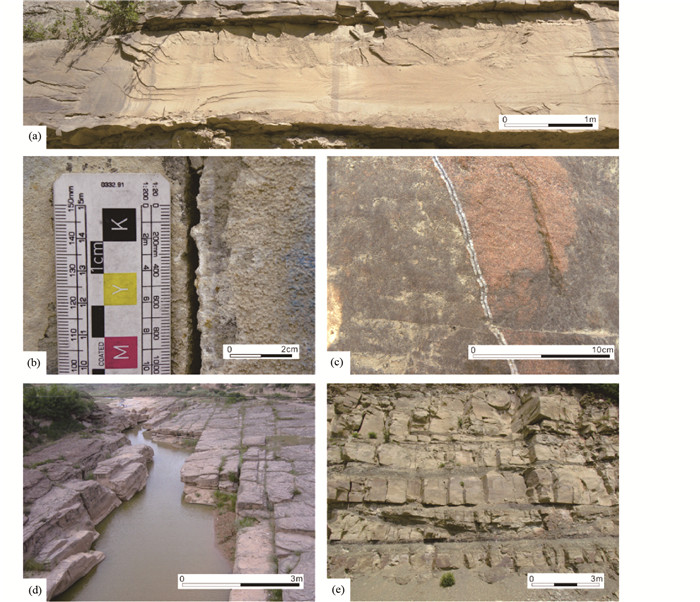
|
图 4 节理露头照片 (a)-节理面上羽饰纹;(b、c)-被方解石脉充填的节理;(d)-系统节理(王锡勇提供);(e)-岩层产状水平,节理垂直于岩层 Fig. 4 Outcrop photographs of joints (a)-plume on the joint surface; (b, c)-the joint is filled by calcite veins; (d)-systen joints (advantage joints); (e)-strata is horizontal and joints perpendicular to the strata |
文中所采用的应力反演方法是基于软件Tensor Program (Delvaux and Sperner, 2003),同时在野外工作中要确保:(1) 单一的系统节理组或是正交节理系统是在一个稳定的应力场中形成的;(2) 用于应力反演的节理为张性节理。在野外可以通过节理的相互接触关系,判断形成的先后时间;同时通过解理面上是否有羽饰纹以及节理面之间的位移是否垂直于节理面来判断节理是否为张性节理(图 1a)。用于应力反演的节理数据都符合上述两个条件,以确保所获得的古应力方向的准确性。通过Tensor Program的应力反演可以获得三个主应力轴的方向以及反映应力椭球体的应变比值(R=(σ2-σ3)/(σ1-σ3))。
在最大主应力(σ1,为压应力) 为垂直方向,中间应力(σ2) 和最小主应力(σ3,为张应力) 位于水平面内的应力场中,正交节理系统是由σ3和σ2的周期性的相互转换所形成的(Caputo,1995;Bai et al., 2002)。首次形成破裂时,应力状态为σ3垂直于破裂面,σ2平行于破裂面;由于先期形成的破裂的存在,使得破裂面附近垂直方向上的应力(σ3) 急剧的降低,局部形成原σ2方向成为最大的张应力,而原σ3方向成为中间应力;在新的应力场中,σ2垂直于已形成的破裂,σ3平行于已形成的破裂面;在新的应力场中形成的破裂面将垂直于已存在的破裂面。在σ3和σ2如此反复交替转换的条件下,则会形成区域上的正交节理系统(图 5)。尽管局部出现应力的改变,但正交节理系统的存在指示了一个远程应力场的持续存在(Caputo,1995;Bai et al., 2002),同时还可以用于推测远程主应力方向以及应力场是否发生旋转。
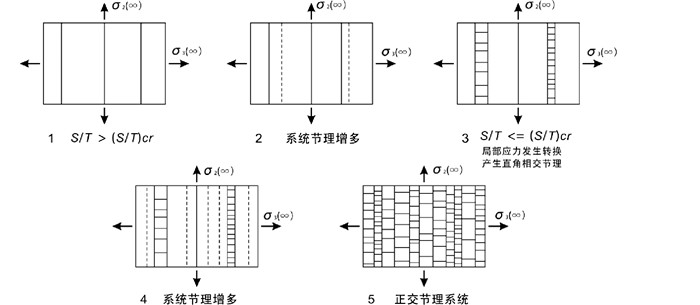
|
图 5 产生正交节理局部应力转换模式图(据Bai, 2002修改) 第1阶段:S/T>(S/T) cr,产生系统节理(优势节理);第2阶段:由于系统节理的增多,出现相邻的系统节理;第3阶段:S/T < =(S/T) cr,局部应力的转换,产生正交节理;第4阶段:系统节理的进一步增多;第5阶段:正交节理系统的形成.S/T为节理间距与层厚之间的比值,(S/T) cr为节理间距与层厚之比的临界值.cr-临界值 Fig. 5 Map of local stress switch model that can lead to the development of orthogonal cross joints (after Bai, 2002) Stage 1: S/T>(S/T) cr, development of the systematic joints (dominant joints); stage 2: appearance of some pairs of systematic joints because of the infilling; stage 3: S/T < =(S/T) cr, development of orthogonal joints due to the local stress switch; stage 4: infilling of more systematic joints; stage 5: orthogonal joint system pattern. Cr-critical value |
由于大面积的黄土覆盖,鄂尔多斯盆地中生代地层主要沿河流和道路出露,从而造成露头面积很小,不利于节理的分期配套研究。对于地层中出现的多组节理,其形成的先后时间主要是通过彼此的接触和切割关系,以及平面上的几何形态来确定。对于区域上近平行、呈面状且延伸远的节理组,称为系统节理,一般为先期形成;而位于系统节理之间或是临近系统节理处产生的节理则是后期形成的。后期形成的节理组在空间上的延伸,一般都要受前期节理组的限制(图 6a-c),但是在终止处的几何形态却是多样的(Hancock,1985;Bai et al., 2002)。正交节理组是典型的梯子形或是“T”形的接触形态(图 5),后期形成的节理组一般以直角相交于前期形成的节理组,并以其为界终止延伸。节理组之间以非直角相交的几何形态也是常见的,例如“Y”形的接触形态等(Hancock,1985)。由于先期节理的形成而引起局部应力场的扰动,这种局部的扰动应力场又会产生新的节理,并且新的节理在邻近老的节理时,解理面往往会发生弯曲,这种弯曲形态又分为平行弯曲和垂直弯曲(Dyer,1988)。以上所提到的这些几何形态,在研究区内都有发现(图 6a-c、图 7)。
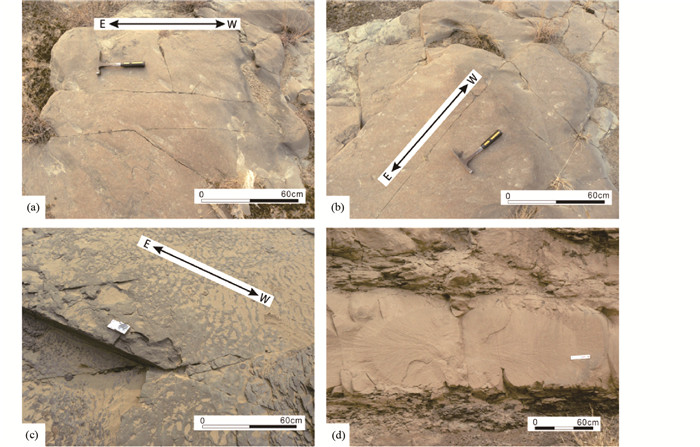
|
图 6 节理组相交接触关系 (a) E-W向节理对SN向和WNW-ESE向两组节理的限制;(b) E-W向节理对SN向和NNE-SSW向两组节理的限制;(c) E-W向节理对WNW-ESE向节理的限制;(d)-节理面上的羽饰纹 Fig. 6 relationship of joint termination and intersection (a) N-S and WNW-ESE trending joint terminate E-W trending joint; (b) N-S and NNE-SSW trending joint terminate E-W trending joint; (c) WNW-ESE trending joint terminate E-W trending joint; (d)-plume on the joint surface |
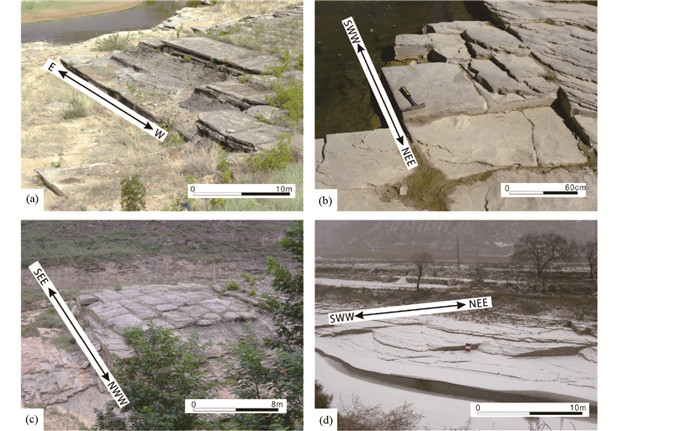
|
图 7 正交节理系统露头照片 (a) E-W向和N-S向两组节理组成的正交节理系统;(b) ENE-WSW向和NNW-SSE向两组节理组成正交节理系统;(c) WNW-ESE向和NNE-SSW向两组节理组成正交节理系统(王锡勇提供);(d) ENE-WSW向和NNW-SSE向两组节理组成正交节理系统 Fig. 7 Outcrop photographs of orthogonal joint system (a)-orthogonal joint system with E-W and N-S trending joint sets; (b)-orthogonal joint system with ENE-WSW and NNW-SSE trending joint sets; (c)-orthogonal joint system with WNW-ESE and NNE-SSW trending joint sets; (d)-orthogonal joint system with ENE-WSW and NNW-SSE trending joint sets |
由于鄂尔多斯盆地自中生代以来经历了多期构造事件,盆地及周缘的远程应力作用十分复杂,由此带来的结果是盆内发育有多套的节理系统,即使是在同一地点同一岩层中,也会出现多组节理(例如图 3中,点3和点15等),给我们的构造解析带来了非常大的难度。我们进行统计的所有节理数据来自86个观测点,节理走向主要通过玫瑰花图来表示(图 3)。在鄂尔多斯盆地东南部,基于节理空间展布状态,划分出六组主要节理(图 8),分别为E-W向、N-S向、ENE-WSW向、NNW-SSE向、WNW-ESE向和NNE-SSW向(图 8)。其中E-W与N-S向节理,ENE-WSW与NNW-SSE向节理,以及WNW-ESE与NNE-SSW向节理分别构成了三套正交节理系统(图 7)。在这个正交节理系中,E-W向、ENE-WSW向和WNW-ESE向节理为优势节理(图 7)。正交节理系统中的两组节理具以下三项特征:(1) 在野外同一露头同一层位中,两组节理以直角相交的形式出现;(2) 其中有一组解理较发育,而另一组在空间上的延伸一般则受前一组的限制;(3) 两组节理中,优势节理的解理面上一般都会有羽饰纹,表明其为张性破裂。

|
图 8 节理迹线图 A1:E-W向节理;A2:N-S向节理;B1:WNW-ESE向节理;B2:NNE-SSW向节理;C1:ENE-WSW向节理;C2:NNW-SSE向节理 Fig. 8 Map of joint trajectory A1: E-W trending joint; A2: N-S trending joint; B1: WNW-ESE trending joint; B2: NNE-SSW trending joint; C1: ENE-WSW trending joint; C2: NNW-SSE trending joint |
在野外观察中,在三叠系和侏罗系地层中大量发育E-W和N-S向的正交节理系统,其中E-W向为优势节理(图 3),E-W和N-S向解理面上均可见羽饰纹(图 4a、图 6d),表明其为张性破裂。同一观测点中同一层位的E-W和N-S向两组节理以正交形式同时出现(图 7a)。在中生界地层ENE-WSW和NNW-SSE向正交节理系统中,优势节理为NEE向(图 7b, d),节理面上也都发育羽饰纹。此外,SEE-NWW和NNE-SSW向节理也以正交节理系统形式出现于中生界地层中(图 7c)。
节理形成的先后时间主要通过节理的接触关系来确定。在野外观察中,发现E-W向节理组对N-S向、NNE-SSW向,以及SEE-NWW向三组节理都有限制(图 6a-c),所以E-W向是最早形成的节理组。由于E-W和N-S向为同一地质时期形成的正交节理系统,同时E-W向和N-S向两组节理主要出露在三叠系和侏罗系中,所以N-S向节理的形成要早于其他四组节理。在其余四组节理中,ESE-WNW向和NNE-SSW向两组节理主要出露在三叠系和侏罗系中,而ENE-WSW向和NNW-SSE向两组节理则在包括白垩系在内的所有中生界地层中都可见(图 3、图 8),说明它们的形成要晚于前两组节理。由此可以确定盆内三套正交节理系统的先后期次是:E-W向和N-S向两组节理最早形成,SEE-NWW向和NNE-SSW向两组节理形成稍晚,而ENE-WSW向和NNW-SSE向两组节理则最晚形成。每套正交节理系统内的优势节理相对早于另一方向节理。
4.2 节理间距节理间距和力学层厚度之间的关系,先后被定量化为节理间距指数(Narr and Suppe, 1991) 和节理间距率(Gross,1993)。节理间距指数(fracture spacing index,FSI) 被定义为:以节理间距为X轴,力学层厚为Y轴,所构成的线性函数的斜率。节理间距率(fracture spacing ratio,FSR) 被定义为节理间距中值除以力学层厚的比值。两者的区别在于FSI表示的是不同层厚的层状岩层中节理发育的强度特征;而FSR表示的是单个力学层中节理发育的强度。一般FSI和FSR的值越大则表示节理间距越密集。在节理间距主要受岩层厚度控制时,FSI和FSR的至近似相等(Gross et al., 1995)。
鄂尔多斯盆地中生代地层中节理间距与层厚之间的关系,文中通过节理间距指数来表示(图 9a)。从图中可以知道,E-W、N-S和ENE-WSW三组节理的间距指数分别为1.15、0.5和1.45,所有数据反映的FSI近似于等于E-W向节理的FSI,此外线性回归系数也很低。这些都表明了,不管是单个节理组还是所有节理的间距数据,节理间距中值和层厚之间都没有很好的线性关系。这与Narr和and Suppe (1991)得到的沉积岩层中的节理间距指数基本为恒定常数1.3并不相符;此外,Eyal et al.(2001)在以色列南部地区研究中,发现节理间距与层厚也不具有很好的线性关系,表明节理间距的发育可能还受其他的因素的控制(Ladeira and Price, 1981;Gross et al., 1995)。关于岩性对节理间距发育的影响,Ladeira et al.(1981)和Gross et al.(1995)先后做过相关研究,认为节理间距的发育除了受层厚的控制,还受岩性、弹性模量、张应变以及微裂隙等因素的影响。从图 9b中可以知道,E-W向和ENE-WSW向两组节理的FSR值分布范围从0.5~3.0都有,而N-S向FSR值主要分布在0.5~1.2之间。Bai et al.(2002)对正交节理系统的研究中发现,当水平应力率大于0.2时,FSR值从大于到小于间距与层厚的临界比值(约1.7) 的变化过程中,节理的发育会经历一个优势节理组的充填到正交节理发育的改变。图 9b中E-W和ENE-WSW向的FSR值的分布范围表明形成这两组节理的所在的应力场均可发生应力转变,形成正交节理系统;而N-S向的FSR值小于临界值,表明其为应力场转换下形成的直角相交节理,进一步确定E-W向和N-S向为同一期的正交节理系统。此外,可知E-W向和ENE-WSW向两组节理在区域上发育强度较大,局部地区节理间距较密集,而N-S向节理组则发育强度相对较弱。这与露头观察到的E-W向和ENE-WSW向为优势节理的现象是一致的(图 3)。
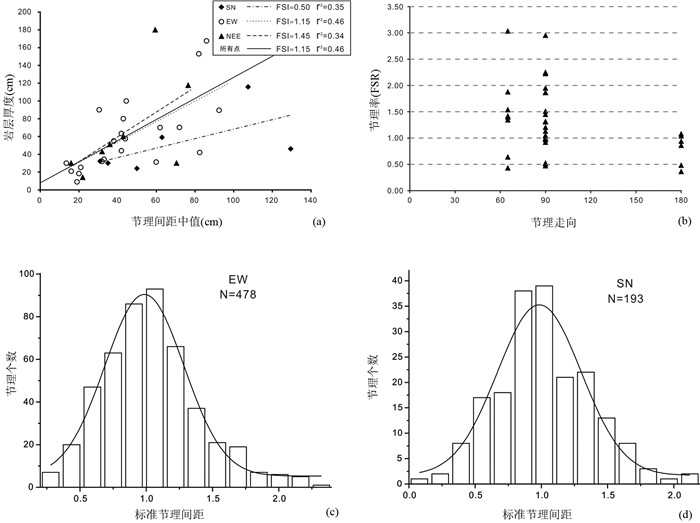
|
图 9 节理间距分析图 (a)-节理间距指数分析图;(b)-节理率分布图;(c) E-W向节理标准节理间距的频率分布直方图;(d) N-S向节理标准节理间距的频率分布直方图 Fig. 9 Analysis chart of joint spacing (a)-map of joint spacing index; (b)-distribution map of joint spacing ratio; (c)-frequency distribution histogram of normalized joint spacing of E-W trending joint; (d)-frequency distribution histogram of normalized joint spacing of N-S trending joint |
对于单一层位中有规则的节理间距,很多学者都有过研究(如:Gillespie et al., 1993),而节理间距频率分布直方图则是对节理发育过程中规律性的一种表示,可以进一步揭示节理的发育程度以及微裂缝的分布对节理发育的影响(Huang and Angelier, 1989;Narr and Suppe, 1991;Rives et al., 1992;Becker and Gross, 1996;Ruf et al., 1998;Rabinovitch and Bahat, 1999;Gillespie et al., 1999)。频率分布直方图需要有大量的数据,其平均值才有实际意义,为了消除岩层厚度对直方图的影响,来自地层中大量节理间距数据需经过所在岩层的中值标准化后,方可一起用于形成频率分布直方图(Narr and Suppe, 1991;Gross,1993;Ruf et al., 1998)。尽管不同地层中的大量节理数据放在一起形成频率分布直方图可能掩盖了如局部应变影响等一些信息,但仍可揭示区域上节理发育的普遍规律(Becker and Gross, 1996)。
将鄂尔多斯盆地中E-W向和N-S向两组出露较好的节理间距数据与其所在层位的间距中值标准化后,分别获得E-W向和N-S向两组节理间距的频率分布直方图(图 9c, d)。图中显示了圆滑单峰状态的正态分布特征,这与前人研究成果(Narr and Suppe, 1991;Ruf et al., 1998;Gillespie et al., 1999) 基本一致。因为频率分布直方图过滤掉局部的应力分布不均一性,所以正态分布特征表明这两组节理都形成于较稳定统一的应力场。由于另外四组节理出露有限,本次研究没有收集到足够的数据用于分析,需待将来的进一步工作。
通过上述分析可知,鄂尔多斯盆地中生界地层中节理间距的发育程度并非完全受层厚控制;又因为所有节理数据均来自于中生代的砂岩层,因此岩性对节理间距的影响也较小;此外,FSR值分布不均,说明了区域上节理发育强度的不均一性。这些都表明鄂尔多斯盆地节理间距的发育程度可能主要受古应力场的控制。
5 讨论:正交节理系统指示的应力场变化在任何时间和地点,所存在的应力张量都是来自于远程的、区域的和局部的各种不同力源的张应力的总和。这种区域应力张量的强度和方向可能随着时间和空间的变化而发生改变。鄂尔多斯盆地自三叠纪末演变成陆内盆地后,周缘区域构造应力场方向曾发生多次转变,本节将在前述各节基础上,对正交节理系统发育特征进行归纳,探讨它们所指示的应力场变化。
对节理和其他破裂的研究表明,脆性变形一般是在区域构造变形较浅的部位,一般由远程应力持续作用形成的(Hancock,1985;Hancock et al., 1984;Engelder,1985;Dunne and North, 1990)。一般在压性的构造环境中,垂直于主压应力的方向上同时会有张性应变的存在(Caputo,1995;Eyal,1996;De Guidi et al., 2013)。前面曾提及鄂尔多斯盆地经历了三叠纪N-S向挤压、早中侏罗世的N-S向拉伸、晚侏罗世的多向挤压以及早白垩世NW-SE向的拉伸作用。同时盆地周缘的大型构造带(图 2),如:近东西向展布的秦岭和阴山-燕山造山带,近N-S向的西缘贺兰山、六盘山逆冲带、东缘近NNE-SSW向的晋西挠褶带等,都暗示了区域上的压应力方向(张泓,1996;万天丰和朱鸿,2002;张岳桥和廖昌珍,2006;徐黎明等,2006;廖昌珍等,2007;王锡勇等,2010)。这些构造事件对盆内是否都有影响?
前人(张泓,1996;万天丰和朱鸿,2002;徐黎明等,2006;张义楷等,2006;王锡勇等,2010) 对鄂尔多斯盆地的节理已做了大量的工作,认为鄂尔多斯盆地在早中生代主要处在N-S向的挤压应力场中,应力来源华北板块与华南板块的碰撞;晚中生代处在NW-SE向的挤压应力场下,主要受太平洋板块向亚洲大陆俯冲产生的远程应力的影响;而在新生代则处于NE-SW向的挤压应力场中,应力来源于印度板块对欧亚板块碰撞所产生的远程效应。这些研究都认为区内发育的节理为X型共轭剪切节理,是由剪切应力作用所形成的(张泓,1996;徐黎明等,2006;张义楷等,2006;王锡勇等,2010)。但文中的研究表明,盆内中生界中发育的节理均为张性节理,并构成三套正交节理系统,且形成的先后期次分别为E-W和N-S向为最早一期,WNW-ESE和NNE-SSW为第二期,ENE-WSW和NNW-SSE向为最晚一期。
对三叠纪和侏罗纪地层中发育的第一期的张性节理数据的应力反演获得的古应力分布为最大张应力的方向近似N-S向(图 10),指示压应力方向为近E-W向。由于这一期节理在白垩系中并没有观察到,因而我们推断第一期节理应为白垩纪以前的构造活动所致。晚侏罗世时,盆地处在一个多向挤压的环境中,这一时期盆地的东西缘都有构造活动(Liu,1998;Darby and Ritts, 2002;刘池洋等,2006),这可能造就了第一期张节理应力所反应的的N-S向拉张,E-W向挤压的应力场,所以第一期正交节理系统应对应于晚侏罗世E-W向的挤压环境下。应力可能来源于太平洋板块向亚洲大陆的俯冲所产生的远程效应。中晚侏罗世太平洋板块俯冲所产生的应力在亚洲大陆东缘主要为NW-SE向的挤压分量,但是当远程应力传播到鄂尔多斯盆地东缘时,挤压应力方向已转变为近E-W向。
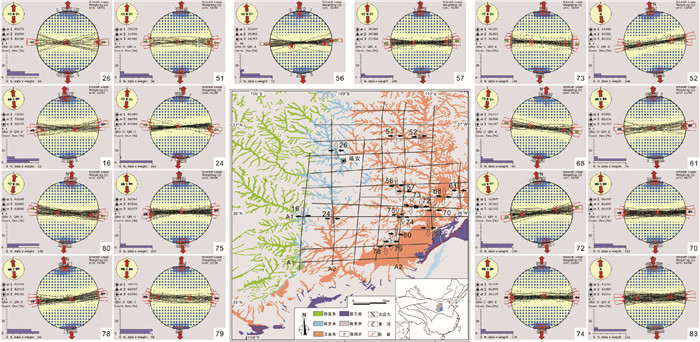
|
图 10 第一期正交节理系统与古应力场 每个观测点用于应力反演的节理数据至少要20个,并且都要为张节理数据,应力反演软件为Tensor program (Delvaux and Sperner, 2003) Fig. 10 Orthogonal joint system and paleostress field in first phase The number of joints data which was used to stress inversion requires at least 20, and data belong to extension joints, software of stress inversion is Tensor program (Delvaux and Sperner, 2003) |
对第二期张节理应力反演获得的最大张应力方向为NNE-SSW向(图 11),表明了压应力的方向为WNW-ESE向。这一期的节理主要分布在三叠系和侏罗系中,白垩系地层中则较少发育(图 8、图 11),推断其形成时间可能为白垩纪中期,其应力来源可能仍为太平洋板块向亚洲大陆下俯冲所产生的远程效应,但此时太平洋板块的俯冲方向已经向NW发生了偏转(Engebretson et al., 1985)。
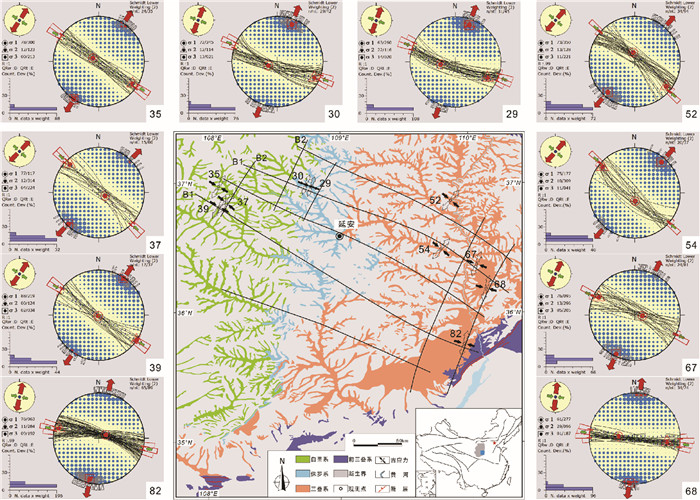
|
图 11 第二期正交节理系统与古应力场 每个观测点用于应力反演的节理数据至少要20个,并且都要为张节理数据,应力反演软件为Tensor program (Delvaux and Sperner, 2003) Fig. 11 Orthogonal joint system and paleostress field in second phase The number of joints data which was used to stress inversion requires at least 20, and data belong to extension joints, software of stress inversion is Tensor program (Delvaux and Sperner, 2003) |
对最晚一期张节理应力反演获得的最大张应力方向为NNW-SSE向(图 12),暗示了此时的压应力方向为ENE-WSW向。同时这一期的节理分布于整个中生代的地层中(图 8、图 12),表明其为晚白垩世以后的构造活动所致。此时的应力来源可能为新生代印度板块与欧亚板块碰撞所产生的NE-SW向的远程挤压应力。

|
图 12 第三期正交节理系统与古应力场 每个观测点用于应力反演的节理数据至少要20个,并且都要为张节理数据,应力反演软件为Tensor program (Delvaux and Sperner, 2003) Fig. 12 Orthogonal joint system and paleostress field in third phase The number of joints data which was used to stress inversion requires at least 20, and data belong to extension joints, software of stress inversion is Tensor program (Delvaux and Sperner, 2003) |
(1) 鄂尔多斯盆地东南部中生界发育六组节理,方向分别为E-W向、N-S向、ENE-WSW向、NNW-SSE向、WNW-ESE向和NNE-SSW向,它们构成三套正交节理系统,分别为E-W与N-S系统、ENE-WSW与NNW-SSE系统、WNW-ESE与NNE-SSW系统,其中E-W向、WNW-ESE向和ENE-WSW向分别为三套正交节理系统中的优势节理。
(2) 上述三套正交节理系统发育的先后期次是:E-W向和N-S向正交节理系统最早,SEE-NWW向和NNE-SSW向正交节理系统次之,ENE-WSW向和NNW-SSE向正交节理系统最晚形成。
(3) E-W向、N-S向和ENE-WSW向三组节理的节理间距指数(FSI) 分析结果表明,研究区节理间距的发育程度除了受岩层厚度控制外,还受区域应力场的控制。
(4) 盆内中生界三期正交节理系统的发育记录了鄂尔多斯盆地古应力场的演化历史。晚侏罗世盆地处于近E-W向挤压环境,应力源于太平洋板块向亚洲大陆的俯冲作用;早白垩世末盆地处于NW-SE向挤压环境,应力仍源于太平洋板块的俯冲作用,但俯冲方向发生偏转;晚白垩世至新生代,盆地处于ENE-WSW向挤压环境,应力源于印度板块与欧亚板块碰撞的远程效应。
致谢 在本项研究过程中,得到了中国科学院地质与地球物理研究所雷裕红博士,陕西延长石油研究院尹锦涛、陈洪亮高工,西安科技大学的李克永教授在野外工作中给予的帮助;中国科学院地质与地球物理研究所林伟研究员对本稿提出了具体详细的修改意见,在此表示衷心感谢。| [] | Bai TX, Gross MR. 1999. Theoretical analysis of cross-joint geometries and their classification. Journal of Geophysical Research, 104(B1): 1163–1177. DOI:10.1029/1998JB900044 |
| [] | Bai TX, Pollard DD. 2000. Fracture spacing in layered rocks: A new explanation based on the stress transition. Journal of Structural Geology, 22(1): 43–57. DOI:10.1016/S0191-8141(99)00137-6 |
| [] | Bai TX, Maerten L, Gross MR, Aydin A. 2002. Orthogonal cross joints: Do they imply a regional stress rotation?. Journal of Structural Geology, 24(1): 77–88. DOI:10.1016/S0191-8141(01)00050-5 |
| [] | Becker A, Gross MR. 1996. Mechanism for joint saturation in mechanically layered rocks: An example from southern Israel. Tectonophysics, 257(2-4): 223–237. DOI:10.1016/0040-1951(95)00142-5 |
| [] | Caputo R. 1995. Evolution of orthogonal sets of coeval extension joints. Terra Review, 7(5): 479–490. |
| [] | Chen J, Wu T. 1997. Regional Strata of North China. Beijing: China University of Geosciences Press: 182-199. |
| [] | Cheng ST, Huang YQ, Fu XH. 1997. Paleogeography reconstruction of the Early-Middle Jurassic Large Ordos Basin and development and evolution of continental downwarping. Acta Sedimentologica Sinica, 15(4): 43–49. |
| [] | Cong BL and Zhang WH. 1984. Mesozoic volcanic rocks in the northern part of Hebei-Shandong fault block and their relations to tectonic features. In: Zhang WY, Wang YP and Li XT (eds.). Formation and Development of the North China Fault Block Region. Beijing: Science Press, 179-191(in Chinese with English abstract) |
| [] | Darby BJ, Ritts BD. 2002. Mesozoic contractional deformation in the middle of the Asian tectonic collage: The enigmatic Western Ordos fold-thrust belt. Earth and Planetary Science Letters, 205(1-2): 13–24. DOI:10.1016/S0012-821X(02)01026-9 |
| [] | Darby BJ, Ritts BD. 2007. Mesozoic structural architecture of the Lang Shan, North-central China: Intraplate contraction, extension, and synorogenic sedimentation. Journal of Structural Geology, 29(12): 2006–2016. DOI:10.1016/j.jsg.2007.06.011 |
| [] | Davis GA, Wang C, Zheng YD, Zhang JJ, Zhang CH, George EG. 1998. The enigmatic Yinshan fold-and-thrust belt of northern China: New views on its intraplate contractional styles. Geology, 26(1): 43–46. DOI:10.1130/0091-7613(1998)026<0043:TEYFAT>2.3.CO;2 |
| [] | Davis GA, Darby BJ. 2010. Early Cretaceous overprinting of the Mesozoic Daqing Shan fold-and-thrust belt by the Hohhot metamorphic core complex, Inner Mongolia, China. Geosciences Frontiers, 1(1): 1–20. DOI:10.1016/j.gsf.2010.08.001 |
| [] | De Guidi G, Caputo R and Scudero S. 2013. Regional and local stress field orientation inferred from quantitative analyses of extension joints: Case study from southern Italy. Tectonics, Accepted https://www.researchgate.net/publication/258816093_Regional_and_local_stress_field_orientation_inferred_from_quantitative_analyses_of_extension_joints_Case_study_from_southern_Italy |
| [] | Delvaux D, Sperner B. 2003. New aspects of tectonic stress inversion with reference to the TENSOR program. Geological Society, London, Special Publications, 212(1): 75–100. DOI:10.1144/GSL.SP.2003.212.01.06 |
| [] | Dong SW, Zhang YQ, Long CX, Yang ZY, Ji Qiang, Wang T, Hu JM, Chen XH. 2007. Jurassic tectonic revolution in China and new interpretation of the Yanshan Movement. Acta Geologica Sinica, 81(11): 1449–1461. |
| [] | Dunne WM, North CP. 1990. Orthogonal fracture systems at the limits of thrusting: An example from southwestern Wales. Journal of Structural Geology, 12: 207–215. DOI:10.1016/0191-8141(90)90005-J |
| [] | Dyer R. 1988. Using joint interactions to estimate paleostress ratios. Journal of Structural Geology, 10(7): 685–699. DOI:10.1016/0191-8141(88)90076-4 |
| [] | Engebretson DC, Cox A, Gordon RG. 1985. Relative motions between oceanic and continental plates in the Pacific basin. Geological Society of American, Special Paper, 206: 1–60. DOI:10.1130/SPE206 |
| [] | Engelder T, Geiser P. 1980. On the use of regional joint sets as trajectories of paleostress fields during the development of the Appalachian Plateau, New York. Journal of Geophysical Research, 85(B11): 6319–6341. DOI:10.1029/JB085iB11p06319 |
| [] | Engelder T. 1982. Is there a genetic relationship between selected regional joints and contemporary stress within the lithosphere of North America?. Tectonics, 1(2): 161–177. DOI:10.1029/TC001i002p00161 |
| [] | Engelder T. 1985. Loading paths to joint propagation during a tectonic cycle: An example from the Appalachian Plateau, U. S.A. Journal of Structural Geology, 7(3-4): 459–476. DOI:10.1016/0191-8141(85)90049-5 |
| [] | Engelder T. 1989. Analysis of pinnate joints in the Mount Desert Island granite: Implications for postintrusion kinematics in the coastal volcanic belt, Maine. Geology, 17(6): 564–567. DOI:10.1130/0091-7613(1989)017<0564:AOPJIT>2.3.CO;2 |
| [] | Engelder T, Gross MR. 1993. Curving cross joints and the lithospheric stress field in eastern North America. Geology, 21(9): 817–820. DOI:10.1130/0091-7613(1993)021<0817:CCJATL>2.3.CO;2 |
| [] | Engelder T and Gross MR and Pinkerton P. 1997. Joint development in clastic rocks of the Elk Basin anticline, Montana-Wyoming. In: Hoak TE, Klawitter AL and Blomquist PK (eds.). An Analysis of Fracture Spacing Versus Bed Thickness in A Basement-Involved Laramide Structure. Fractured Reservoirs; Characterization and Modeling. Colorado: Rocky Mountain Association of Geologists, 1-18 |
| [] | Enkin RJ, Yang ZY, Chen Y, Courtillot V. 1992. Paleomagnetic constraints on the geodynamic history of the major blocks of China from the Permian to the present. Journal of Geophysical Research, 97(B10): 13953–13989. DOI:10.1029/92JB00648 |
| [] | Eyal Y. 1996. Stress field fluctuations along the Dead Sea Rift since the Middle Miocene. Tectonics, 15(1): 157–170. DOI:10.1029/95TC02619 |
| [] | Eyal Y, Gross MR, Engelder T, Becker A. 2001. Joint development during fluctuation of the regional stress field in southern Israel. Journal of Structural Geology, 23(2-3): 279–296. DOI:10.1016/S0191-8141(00)00096-1 |
| [] | Gao SL, Han QJ, Yang H, Lin FX, Lin HB. 2000. Yanshanian Movement in Ordos Basin and its relationship with distribution of Oil and Gas. Journal of Changchun University of Science and Technology, 30(4): 353–358. |
| [] | Gillespie PA, Howard CB, Walsh JJ, Watterson J. 1993. Measurement and characterization of spatial distributions of fractures. Tectonophysics, 226(1-4): 113–141. DOI:10.1016/0040-1951(93)90114-Y |
| [] | Gillespie PA, Johnston JD, Loriga MA, McCaffrey KJW, Walsh JJ and Watterson J. 1999. Influence of layering on vein systematic in line samples. In: McCaffrey KJW, Lonergan L and Wilkinson JJ (eds.). Fractures, Fluid Flow and Mineralization. Geological Society, London, Special Publication, 155(1): 35-56 |
| [] | Gross MR, Engelder T. 1991. A case for neotectonic joints along the Niagara escarpment. Tectonics, 10(3): 631–641. DOI:10.1029/90TC02702 |
| [] | Gross MR. 1993. The origin and spacing of cross joints: Examples from the Monterey Formation, Santa Barbara Coastline, California. Journal of Structural Geology, 15(6): 737–751. DOI:10.1016/0191-8141(93)90059-J |
| [] | Gross MR, Fischer MP, Engelder T and Greenfield RJ. 1995. Factors controlling joint spacing in interbedded sedimentary rocks: Integrating numerical models with field observation from the Monterey Formation, USA. In: Ameen MS (ed.). Fractography: Fracture Topography as a Tool in Fracture Mechanics and Stress Analysis. Geological Society Special Publication, 92: 215-233 |
| [] | Gross MR, Bahat D, Becker A. 1997. Relations between jointing and faulting based on fracture-spacing ratios and fault-slip profiles: A new method to estimate strain in layered rocks. Geology, 25(10): 887–890. DOI:10.1130/0091-7613(1997)025<0887:RBJAFB>2.3.CO;2 |
| [] | Hancock PL, Al Kadhi A, Sha'at NA. 1984. Regional joint sets in the Arabian platform as indicators of intraplate processes. Tectonics, 3(1): 27–43. DOI:10.1029/TC003i001p00027 |
| [] | Hancock PL. 1985. Brittle microtectonics: Principles and practice. Journal of Structural Geology, 7(3-4): 437–457. DOI:10.1016/0191-8141(85)90048-3 |
| [] | Hancock PL, Al Kadhi A, Barka AA, Bevan TG. 1987. Aspect of analyzing brittle structures. Annales Tectonicae, 1: 5–19. |
| [] | Hancock PL. 1988. Neotectonic fractures formed during extension at shallow crustal depths. Memoir of the Geological Society of China, 9: 201–226. |
| [] | Hancock PL, Engelder T. 1989. Neotectonic joints. Geological Society of America Bulletin, 101(10): 1197–1208. DOI:10.1130/0016-7606(1989)101<1197:NJ>2.3.CO;2 |
| [] | Hancock PL, Maddock R, Zoback M L, Skipp B, Vita-Finzi C. 1991. Determining contemporary stress directions from neotectonic joint systems. Philosophical Transactions of the Royal Society A: Mathematical, Physical and Engineering Sciences, 337(1645): 29–40. DOI:10.1098/rsta.1991.0104 |
| [] | Hobbs DW. 1967. The formation of tension joints in sedimentary rocks: An explanation. Geological Magazine, 104(6): 550–556. DOI:10.1017/S0016756800050226 |
| [] | Hodgson RA. 1961a. Regional study of jointing in Comb Ridge-Navajo Mountain area, Arizona and Utah. Bulletin of the American Association of Petroleum Geologists, 45(1): 1–38. |
| [] | Hodgson RA. 1961b. Classification of structures on joint surfaces. American Journal of Science, 259(7): 493–502. DOI:10.2475/ajs.259.7.493 |
| [] | Hou GT, Wang YX, Hari KR. 2010. The Late Triassic and Late Jurassic stress fields and tectonic transmission of North China craton. Journal of Geodynamics, 50(3-4): 318–324. DOI:10.1016/j.jog.2009.11.007 |
| [] | Huang Q, Angelier J. 1989. Fracture spacing and its relation to bed thickness. Geological Magazine, 126(4): 355–362. DOI:10.1017/S0016756800006555 |
| [] | Ji SC, Saruwatari K. 1998. A revised model for the relationship between joint spacing and layer thickness. Journal of Structural Geology, 20(11): 1495–1508. DOI:10.1016/S0191-8141(98)00042-X |
| [] | Khadkikar AS. 2002. Late Quaternary neotectonic joints: Confirmation of the connection between jointing and contemporary tectonic stress. Geophysical Research Letters, 29(11): 52–1. |
| [] | Ladeira FL, Price NJ. 1981. Relationship between fracture spacing and bed thickness. Journal of Structural Geology, 3(2): 179–183. DOI:10.1016/0191-8141(81)90013-4 |
| [] | Li XP, Li G, Zang HR, Li XD. 2006. Mesozoic tectonic events in Ordos Basin and their sedimentary responses. Journal of Xi'an Shiyou University (Natural Science Edition), 21(3): 1–4. |
| [] | Liao CZ, Zhang YQ, Wen CS. 2007. Structural styles of the eastern boundary zone of the Ordos basin and its regional tectonic significance. Acta Geologica Sinica, 81(4): 466–474. |
| [] | Lin W, Wang QC. 2006. Late Mesozoic extensional tectonics in the North China Block: A crustal response to subcontinental mantle removal?. Bulletin de la Société Géologique de France, 177(6): 287–294. DOI:10.2113/gssgfbull.177.6.287 |
| [] | Lin W, Faure M, Monie P, Wang QC. 2007. Polyphase Mesozoic tectonics in the eastern part of the North China Block: Insights from the Eastern Liaoning Peninsula massif (NE China). In: Zhai MG, Windley BF, Kusky TM and Meng QR (eds.). Mesozoic Sub-continental Lithospheric Thinning under Eastern Asia. Geological Society of London, Special Publications, 280: 153-169 |
| [] | Lin W, Faure M, Monié P, Schärer U, Panis D. 2008. Mesozoic extensional tectonics in Eastern Asia: The South Liaodong Peninsula metamorphic core complex (NE China). Journal of Geology, 116(2): 134–154. DOI:10.1086/527456 |
| [] | Lin W, Wang QC, Wang J, Wang F, Chu Y, Chen K. 2011. Late Mesozoic extensional tectonics of the Liaodong Peninsula massif: Response of crust to continental lithosphere destruction of the North China Craton. Science in China (Series D), 54(6): 843–857. DOI:10.1007/s11430-011-4190-5 |
| [] | Lin W, Faure M, Chen Y, Ji WB, Wang F, Wu L, Charles N, Wang J, Wang QC. 2013. Late Mesozoic compressional to extensional tectonics in the Yinwulüshan massif, NE China and its bearing on the evolution of the Yinshan-Yanshan orogenic belt Part I: Structural analyses and geochronological constraints. Gondwana Research, 23(1): 54–77. DOI:10.1016/j.gr.2012.02.013 |
| [] | Liu CY, Zhao HG, Gui XJ, Yue LP, Zhao JF, Wang JQ. 2006. Space-time coordinate of the evolution and reformation and mineralization response in Ordos basin. Acta Geologica Sinica, 80(5): 617–638. |
| [] | Liu JL, Davis GA, Ji M, Guan HM, Bai XD. 2008. Crustal detachment and destruction of the keel of North China Craton: Constraints from Late Mesozoic extensional structures. Earth Science Frontiers, 15(3): 72–81. DOI:10.1016/S1872-5791(08)60063-9 |
| [] | Liu SF. 1998. The coupling mechanism of basin and orogen in the western Ordos Basin and adjacent region of China. Journal of Asian Earth Science, 16(4): 369–383. DOI:10.1016/S0743-9547(98)00020-8 |
| [] | Luo JQ, He ZM. 2008. Tectonic evolution and oil-gas distribution in the Mesozoic Ordos Basin. Geology and Resources, 17(2): 135–138. |
| [] | Mandl G. 2005. Rock Joints: The Mechanical Genesis. Berlin Heidelberg: Springer-Verlag: 101–105. |
| [] | Meng QR, Zhang GW. 2000. Geologic framework and tectonic evolution of the Qinling orogen, central China. Tectonophysics, 323(3-4): 183–196. DOI:10.1016/S0040-1951(00)00106-2 |
| [] | Meng XH, Ge M, Tucker ME. 1997. Sequence stratigraphy, sea-level changes and depositional systems in the Cambro-Ordovician of the North China carbonate platform. Sedimentary Geology, 114(1-4): 189–222. DOI:10.1016/S0037-0738(97)00073-0 |
| [] | Muller OH, Pollard DD. 1977. The stress state near Spanish Peaks, Colorado determined from a dike pattern. Pure and Applied Geophysics, 115(1-2): 69–86. DOI:10.1007/BF01637098 |
| [] | Narr W, Suppe J. 1991. Joint spacing in sedimentary rocks. Journal of Structural Geology, 13(9): 1037–1048. DOI:10.1016/0191-8141(91)90055-N |
| [] | Pollard DD, Aydin A. 1988. Progress in understanding jointing over the past century. Geological Society of America Bulletin, 100(8): 1181–1204. DOI:10.1130/0016-7606(1988)100<1181:PIUJOT>2.3.CO;2 |
| [] | Rabinovitch A, Bahat D. 1999. Model of joint spacing distribution based on shadow compliance. Journal of Geophysical Research, 104(B3): 4877–4886. DOI:10.1029/98JB02732 |
| [] | Ren JY, Tamaki K, Li ST, Zhang JX. 2002. Late Mesozoic and Cenozoic rifting and its dynamic setting in Eastern China and adjacent areas. Tectonophysics, 344(3-4): 175–205. DOI:10.1016/S0040-1951(01)00271-2 |
| [] | Renshaw CE. 1997. Mechanical controls on the spatial density of opening-mode fracture networks. Geology, 25(10): 923–926. DOI:10.1130/0091-7613(1997)025<0923:MCOTSD>2.3.CO;2 |
| [] | Ritts BD, Darby BJ, Cope T. 2001. Early Jurassic extensional basin formation in the Daqing Shan segment of the Yinshan Belt, northern North China Block, Inner Mongolia. Tectonophysics, 339(3-4): 239–258. DOI:10.1016/S0040-1951(01)00115-9 |
| [] | Ritts BD, Hanson AD, Darby BJ, Nanson L, Berry A. 2004. Sedimentary record of Triassic intraplate extension in North China: Evidence from the nonmarine NW Ordos Basin, Helan Shan and Zhouzi Shan. Tectonophysics, 386(3-4): 177–202. DOI:10.1016/j.tecto.2004.06.003 |
| [] | Ritts BD, Weislogel A, Graham SA, Darby B. 2009. Mesozoic tectonics and sedimentation of the giant polyphase nonmarine intraplate Ordos Basin, Western North China Block. International Geology Review, 51(2): 95–115. DOI:10.1080/00206810802614523 |
| [] | Rives T, Razack M, Petit JP, Rawnsley KD. 1992. Joint spacing: Analogue and numerical simulations. Journal of Structural Geology, 14(8-9): 925–937. DOI:10.1016/0191-8141(92)90024-Q |
| [] | Rives T, Rawnsley KD, Petit JP. 1994. Analogue simulation of natural orthogonal joint set formation in brittle varnish. Journal of Structural Geology, 16(3): 419–429. DOI:10.1016/0191-8141(94)90045-0 |
| [] | Ruf JC, Rust KA, Engelder T. 1998. Investigating the effect of mechanical discontinuities on joint spacing. Tectonophysics, 295(1-2): 245–257. DOI:10.1016/S0040-1951(98)00123-1 |
| [] | Scholz CH. 1990. The Mechanics of Earthquakes and Faulting. Cambridge: Cambridge University Press: 8-22. |
| [] | Sun JB, Chen G, Zhang RH, Bai GJ, Li XD, Li XP. 2006. Peak ages and sedimentary responses of the Mesozoic-Cenozoic tectonic events in Ordos Basin. Northwestern Geology, 39(3): 91–96. |
| [] | Wan TF, Zhu H. 2002. Tectonics and environment change of Meso-Cenozoic in China continent and its adjacent areas. Geoscience, 16(2): 107–120. |
| [] | Wang HZ, He GQ, Zhang SH. 2006. The geology of China and Mongolia. Earth Science Frontiers, 13(6): 1–13. |
| [] | Wang JP and Yang YD. 1986. Thrust Tectonic Mechanisms of Daqing Mountain and Adjacent Regions. Beijing: Geological Publishing House, 1-16(in Chinese with English abstract)? |
| [] | Wang T, Zheng YD, Zhang JJ, Zeng LS, Donskaya T, Guo L, Li JB. 2011. Pattern and kinematic polarity of Late Mesozoic extension in continental NE Asia: Perspectives from metamorphic core complexes. Tectonics, 30(6): TC6007. |
| [] | Wang XY, Zhang QL, Wang LS, Ge RF, Chen J. 2010. Structural features and tectonic stress fields of the Mesozoic and Cenozoic in the eastern margin of the Ordos basin, China. Geological Bulletin of China, 29(8): 1168–1176. |
| [] | Wu HQ, Pollard DD. 1995. An experimental study of the relationship between joint spacing and layer thickness. Journal of Structural Geology, 17(6): 887–905. DOI:10.1016/0191-8141(94)00099-L |
| [] | Xu LM, Zhou LF, Zhang YK, Dand B. 2006. Characteristics and tectonic setting of tectono-stress field of Ordos Basin. Geotectonica et Metallogenia, 30(4): 455–462. |
| [] | Yang XK, Chao HX, Volkova NI, Zheng ML, Yao WH. 2009. Geochemistry and SHRIMP geochronology of alkaline rocks of the Zijinshan massif in the eastern Ordos basin, China. Russian Geology and Geophysics, 50: 751–762. DOI:10.1016/j.rgg.2009.08.002 |
| [] | Zhang H. 1996. Mesozoic and Cenozoic palaeotectono-stress field of Ordos basin. Journal Geology and Mineral of North China, 11(2): 87–92. |
| [] | Zhang YK, Zhou LF, Dang B, Bai B. 2006. Characteristics of distribution of the field outcrop fracture systems in Triassic and Jurassic in central-east Ordos Basin. Geotectonica et Metallogenia, 30(2): 168–173. |
| [] | Zhang YQ, Ma YS, Yang N, Shi W, Dong SW. 2003. Cenozoic extensional stress evolution in North China. Journal of Geodynamics, 36(5): 591–613. DOI:10.1016/j.jog.2003.08.001 |
| [] | Zhang YQ, Liao CZ. 2006. Transition of the Late Mesozoic-Cenozoic tectonic regimes and modification of the Ordos basin. Geology in China, 33(1): 28–40. |
| [] | Zhang YQ, Shi W, Liao CZ. 2006a. Fault kinematic analysis and change in Late Mesozoic tectonic stress regimes in the peripheral zones of the Ordos Basin, North China. Acta Geologica Sinica, 80(5): 639–647. |
| [] | Zhang YQ, Liao CZ, Shi W, Hu B. 2006b. Neotectonic evolution of the peripheral zones of the Ordos Basin and geodynamic setting. Geological Journal of China Universities, 12(3): 285–297. |
| [] | Zhang YQ, Dong SW, Zhao Y, Zhang T. 2007a. Jurassic tectonics of North China: A synthetic view. Acta Geologica Sinica, 81(11): 1462–1480. |
| [] | Zhang YQ, Liao CZ, Shi W, Zhang T, Guo FF. 2007b. Jurassic deformation in and around the Ordos Basin, North China. Earth Science Frontiers, 14(2): 182–196. DOI:10.1016/S1872-5791(07)60016-5 |
| [] | Zhang YQ, Shi W, Dong SW. 2011. Changes of Late Mesozoic tectonic regimes around the Ordos Basin (North China) and their geodynamic implications. Acta Geologica Sinica, 85(6): 1254–1276. DOI:10.1111/j.1755-6724.2011.00586.x |
| [] | Zhao ZY, Guo YR, Wang Y, Lin DJ. 2012. Study progress in tectonic evolution and paleogeography of Ordos Basin. Special Oil & Gas Reservoirs, 19(5): 15–20. |
| [] | Zheng YD, Davis DA, Wang Z, Drby BJ, Hua YG. 1998. Major thrust sheet in the Daqinshan Mountians, Inner Mongolia, China. Science in China (Series D), 41(5): 553–560. DOI:10.1007/BF02877747 |
| [] | Zoback ML, Zoback MD. 1980. State of stress in the conterminous United States. Journal of Geophysical Research, 85(B11): 6113–6156. DOI:10.1029/JB085iB11p06113 |
| [] | Zoback ML. 1992. First-and second-order patterns of stress in the lithosphere: The world stress map project. Journal of Geophysical Research, 97(B8): 11703–11728. DOI:10.1029/92JB00132 |
| [] | Zorin YA. 1999. Geodynamics of the western part of the Mongolia-Okhotsk collisional belt, Trans-Baikal region (Russia) and Mongolia. Tectonophysics, 306(1): 33–56. DOI:10.1016/S0040-1951(99)00042-6 |
| [] | 陈晋镳, 武铁山. 1997. 华北区区域地层. 北京: 中国地质大学出版社: 182-199. |
| [] | 程守田, 黄焱球, 付雪洪. 1997. 早中侏罗世大鄂尔多斯古地理重建与内陆拗陷的发育演化. 沉积学报, 15(4): 43–49. |
| [] | 从柏林, 张雯华. 1984.冀鲁断块北部中生代火山岩及其与地质构造的关系.见:张文佑, 汪一鹏, 李兴唐主编. 1984.华北断块区的形成与发展.北京:科学出版社, 179-191 |
| [] | 董树文, 张岳桥, 龙长兴, 杨振宇, 季强, 王涛, 胡建明, 陈宣华. 2007. 中国侏罗纪构造变革与燕山运动新诠释. 地质学报, 81(11): 1449–1461. |
| [] | 高山林, 韩庆军, 杨华, 蔺方晓, 蔺宏斌. 2000. 鄂尔多斯盆地燕山运动及其与油气关系. 长春科技大学学报, 30(4): 353–358. |
| [] | 李向平, 陈刚, 章辉若, 李向东. 2006. 鄂尔多斯盆地中生代构造事件及其沉积响应特点. 西安石油大学学报(自然科学版), 21(3): 1–4. |
| [] | 廖昌珍, 张岳桥, 温长顺. 2007. 鄂尔多斯盆地东缘边界带构造样式及其区域构造意义. 地质学报, 81(4): 466–474. |
| [] | 刘池洋, 赵红格, 桂小军, 岳乐平, 赵俊峰, 王建强. 2006. 鄂尔多斯盆地演化-改造的时空坐标及其成藏(矿) 响应. 地质学报, 80(5): 617–638. |
| [] | 罗建强, 何忠明. 2008. 鄂尔多斯盆地中生代构造演化特征及油气分布. 地质与资源, 17(2): 135–138. |
| [] | 孙建博, 陈刚, 章辉若, 白国绢, 李向东, 李向平. 2006. 鄂尔多斯盆地中新生代构造事件的峰值年龄及其沉积响应. 西北地质, 39(3): 91–96. |
| [] | 万天丰, 朱鸿. 2002. 中国大陆及邻区中生代-新生代大地构造与环境变迁. 现代地质, 16(2): 107–120. |
| [] | 王鸿祯, 何国琦, 张世红. 2006. 中国与蒙古之地质. 地学前缘, 13(6): 1–13. |
| [] | 王建平, 杨玉东. 1986.大青山及邻区冲断推覆构造形成机制的讨论.见:构造地质论丛(6).北京:地质出版社, 1-16 |
| [] | 王锡勇, 张庆龙, 王良书, 葛荣峰, 陈娟. 2010. 鄂尔多斯盆地东缘中-新生代构造特征及构造应力场分析. 地质通报, 29(8): 1168–1176. |
| [] | 徐黎明, 周立发, 张义楷, 党犇. 2006. 鄂尔多斯盆地构造应力场特征及其构造背景. 大地构造与成矿学, 30(4): 455–462. |
| [] | 张泓. 1996. 鄂尔多斯盆地中新生代构造应力场. 华北地质矿产杂志, 11(1): 87–92. |
| [] | 张义楷, 周立发, 党犇, 白斌. 2006. 鄂尔多斯盆地中东部三叠系、侏罗系露头区裂缝体系展布特征. 大地构造与成矿学, 30(2): 168–173. |
| [] | 张岳桥, 廖昌珍. 2006. 晚中生代-新生代构造体制转换与鄂尔多斯盆地改造. 中国地质, 33(1): 28–40. |
| [] | 张岳桥, 施炜, 廖昌珍, 胡博. 2006a. 鄂尔多斯盆地周边断裂运动学分析与晚中生代构造应力体制转换. 地质学报, 80(5): 639–647. |
| [] | 张岳桥, 廖昌珍, 施炜, 胡博. 2006b. 鄂尔多斯盆地周边地带新构造演化及其区域动力学背景. 高校地质学报, 12(3): 285–297. |
| [] | 张岳桥, 董树文, 赵越, 张田. 2007a. 华北侏罗纪大地构造:综评与新认识. 地质学报, 81(11): 1462–1480. |
| [] | 张岳桥, 廖昌珍, 施炜, 张田, 郭芳芳. 2007b. 论鄂尔多斯盆地及其周缘侏罗纪变形. 地学前缘, 14(2): 182–196. |
| [] | 赵振宇, 郭彦如, 王艳, 林冬娟. 2012. 鄂尔多斯盆地构造演化及古地理特征研究进展. 特种油气藏, 19(5): 15–20. |
| [] | 郑亚东, DavisGA, 王琮, DrbyBJ, 华永刚. 1998. 内蒙古大青山大型逆冲推覆构造. 中国科学(D辑), 28(4): 289–295. |
 2013, Vol. 29
2013, Vol. 29

